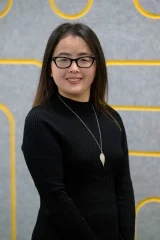We asked Professor Yijiao Jiang, Chair of Macquarie Women in Engineering, about her research and highlights of her work
1. How long have you been at Macquarie University and what brought you here? I came to Macquarie University in 2014 because it had a very good international reputation in my areas of interest, with researchers like Professor Noel Cant, who has since passed away, but who was world-famous for his work in the field of environmental catalysis. Macquarie has retained its strong reputation for its environment and energy research, and has very good facilities, with Professor Peter Nelson and others continuing to do significant research in physical chemistry and spectroscopy.
I came to Macquarie University in 2014 because it had a very good international reputation in my areas of interest, with researchers like Professor Noel Cant, who has since passed away, but who was world-famous for his work in the field of environmental catalysis. Macquarie has retained its strong reputation for its environment and energy research, and has very good facilities, with Professor Peter Nelson and others continuing to do significant research in physical chemistry and spectroscopy.
I moved to Australia from Europe, due to family reasons. I’m originally from China, where I studied my Bachelor’s and Master’s degrees in Environmental Engineering at Kunming University. Then I did my PhD at the University of Stuttgart in Germany, then did a post-doctoral fellowship at ETH in Switzerland.
2. Tell us about some of the research you have been doing since joining Macquarie University.
When I joined Macquarie, the university was growing their Engineering capabilities and I was able to work independently and to set up everything from scratch in my area of specialty, building the labs and establishing projects around renewable energy production. For example, my recent research has investigated ways to more efficiently convert carbon dioxide into chemicals used in industry, such as carbon monoxide or methanol. I have developed new spectroscopic techniques, which have allowed me to achieve breakthroughs in catalysis research, and I have more than a hundred papers published in high-impact journals.
A lot of my work currently is around trying to convert waste into resources. I am working on a project to build a pilot plant to treat municipal solid waste. I am also working on a project to use electrochemical reduction to convert carbon dioxide into valuable chemicals.
3. Tell us about your teaching and mentoring work, and what you enjoy about this
On joining Macquarie, I helped set up the new program of mechanical engineering, which saw our first cohort join in 2013. I helped to create the new units for their third year and fourth year of the program. Our first graduates were in 2016, and we still have very good undergraduate intake numbers and have had a very strong cohort go through each year since then.
We are continuing to expand Macquarie’s engineering program, and students have a lot of options in these undergraduate and postgraduate degrees, with streams in electrical engineering, telecommunications and electronics engineering, mechatronics and mechanical engineering and also civil engineering.
The combination of teaching and research is a very important part of my role because we want to make sure our students are at the cutting edge of the new discoveries and new work that is underway.
When I joined Macquarie, I was one of just two female academics in Engineering. We established Macquarie Women in Engineering Committee in 2018. We promote the role of women in engineering not only for academics, but also for undergraduate and postgraduate students – so we now have women’s engineering student associations as well, and we are growing our numbers.
4. What will you focus on during 2024?
Next year is an important year – we are in the design stages of a major ARC project, to build a pilot plant which will treat 10 tonnes of bioprocessed municipal solid waste per day, converting this into hydrogen. The plant will take a range of waste, including sewage sludge, from wastewater treatment plants; it will also take domestic waste which can include a lot of plastics.
Our pilot plant will convert the waste (which can be up to 70 per cent carbon) into useful products. Instead of incineration, which is commonly used internationally and is not very efficient, our project will trial gasification. We will prevent this waste from adding to carbon dioxide emissions from landfill, by converting the carbon in these materials to carbon monoxide. This chemical is an important feedstock in a range of chemical industrial processes that produce products that can include certain foods, medicines and cosmetics. Carbon can also be converted into carbon materials – such as carbon nanotubes; but that’s not in the scope of this project. Over the next few years, we will oversee the construction and also the installation and commissioning of the plant.
I have a number of other projects also underway including the ARC Industrial Transformation Research Hub for Smart Process Design and Control and an ARC Discovery project which is for the electrochemical reduction of carbon dioxide.